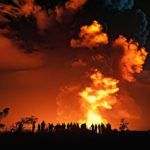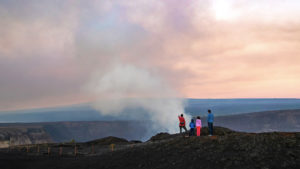
The return of lava to Kīlauea volcano has resulted in a sharp increase in visitors to Hawaii Volcanoes National Park, but Park officials say there has been a rise in people going into closed areas to try to get close to the lava lake inside Halema’uma’u Crater.
The eruption is contained within a closed area at the summit crater, Halemaʻumaʻu, where a rising lava lake is being fed by two vents gushing molten rock. Dangerous levels of volcanic gas, rockfalls, explosions and volcanic glass particulates are the primary hazards, according to USGS Hawaiian Volcano Observatory scientists. The area has been closed since 2007.
Today, there are good views of the plume of gas and steam during the day, and after dark, the plume glows with the colors of the eruption. There is not a direct view of the lava erupting into the crater.
Crater edges at Halemaʻumaʻu and along Kīlauea caldera are extremely unstable, and collapses can occur at any time. Visitors should stay back from cliff edges and heed closure notices and barriers.
Despite these potentially lethal hazards, park rangers have cited dozens of careless individuals intent on snapping a photo or video for social media bragging rights.
“All it takes is a slight change in wind direction and these offenders could inhale a fatal dose of volcanic gas. One misstep or a crumbling cliff edge and they could plunge into the vast pit of molten rock or to the crater floor,” said Chief Ranger Jack Corrao. “We want to keep the park open so everyone can safely experience this beautiful new eruption, but when visitors enter closed areas, rangers must concentrate on these few individuals. This puts our staff in hazardous situations and causes them to shift their focus away from the safety of visitors experiencing the eruption in designated viewing areas,” Corrao said.
Designated viewing areas that are open 24 hours a day include Waldron Ledge, Wahinekapu, Mauna Loa Lookout, Keanakākoʻi and Volcano House. Kīlauea Overlook is best visited before sunrise to avoid crowds. Park spokeswoman Jessica Ferracane says the Kilauea Overlook area is extremely crowded from around 6 p.m. until 10 p.m., so visiting outside those hours will allow a better visit without so many people.
Visitors are warned that even open areas also present hazards, especially near unstable cliff edges and during periods of poor air quality.
Park officials remind the public to recreate responsibly and heed these precautions:
- • Volcanic eruptions can be hazardous and change at any time.
- • Stay on marked trails and overlooks, and avoid earth cracks and cliff edges. Do not enter closed areas.
- • Hazardous volcanic gases are billowing out the crater and present a danger to everyone, especially people with heart or respiratory problems, infants, young children and pregnant women. Go to www.hawaiiSO2network.com to monitor conditions.
- • Slow down and drive safely.
- • Maintain social distance of six feet from others and wear a mask to reduce the spread of COVID-19. Masks do not protect against volcanic gas.

Photos courtesy Hawaii Volcanoes National Park